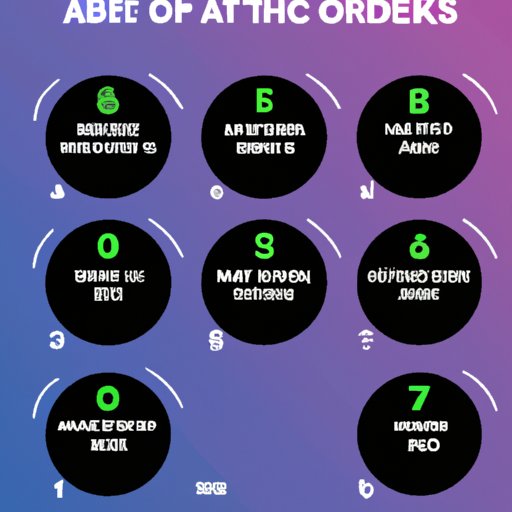Introduction
Six pack abs are one of the most sought-after physical features. The idea that you can achieve a ripped core through diet and exercise is often appealing, but the science behind it is often misunderstood. In this article, we’ll explore the role of nutrition and exercise in developing a defined core, as well as some of the best practices for achieving a flat stomach.

Analyzing the Role of Nutrition in Building Six Pack Abs
Nutrition plays a key role in abdominal development. When it comes to building six pack abs, macronutrients are especially important. Macronutrients are the building blocks of food and include proteins, carbohydrates, and fats. Each macronutrient has its own unique role in the body, and understanding their importance is essential to developing a ripped core.
Proteins are the building blocks of muscle, and adequate amounts of protein are essential for muscle growth. Eating high-quality sources of protein, such as lean meats, eggs, and dairy, can help ensure that your muscles have the fuel they need to grow. Carbohydrates provide energy for the body, which is essential for engaging in physical activity. Complex carbohydrates, such as whole grains, fruits, and vegetables, are the best sources of energy. Lastly, fats are important for hormone production and should be consumed in moderation. Healthy fats, such as fatty fish, nuts, and seeds, are beneficial for abdominal development.
It’s also important to understand the energy balance equation. This equation states that in order to lose weight, you must create a calorie deficit by burning more calories than you consume. This means that if you want to achieve a flat stomach, you must eat fewer calories than you burn. This can be accomplished through proper nutrition and exercise.

The Best Foods for Developing a Ripped Core
When it comes to nutrition for abdominal muscles, there are certain types of foods that are particularly beneficial. High-protein foods are essential for muscle growth, so eating lean proteins, such as chicken, fish, and eggs, can help ensure that your muscles have the fuel they need to build. Complex carbs are also important for sustained energy and should be incorporated into your diet. Examples of complex carbs include whole grains, fruits, and vegetables. Lastly, healthy fats are beneficial for hormone production and should be consumed in moderation. Good sources of healthy fats include fatty fish, nuts, and seeds.

Crafting an Effective Meal Plan for Abdominal Muscles
Once you’ve chosen the right foods for your abdominal muscles, it’s time to craft an effective meal plan. It’s important to select the right foods, as well as portion them correctly. Eating too much or too little of any particular food can hinder your progress towards a ripped core. Additionally, timing your meals correctly can make a huge difference in your results. Eating smaller, more frequent meals throughout the day can help keep your energy levels up and promote muscle growth.
Finally, it’s important to set realistic goals. Trying to achieve a six pack in a short amount of time is rarely possible and can lead to frustration and disappointment. Aiming for gradual improvements over time is usually a better approach.
Exploring the Benefits of Intermittent Fasting for Defined Abs
Intermittent fasting is another popular method for developing flat stomachs. This type of fasting involves alternating periods of eating and fasting. During the fasting period, no food is consumed, but water, tea, and other non-caloric beverages are typically allowed. Intermittent fasting has been shown to have numerous health benefits, including improved metabolism and increased fat burning. Additionally, it can help reduce hunger and cravings, making it easier to stick to a healthy eating plan.
Before trying intermittent fasting, it’s important to make sure that it’s safe for you. Consult with your doctor to determine whether intermittent fasting is right for you.
Examining the Science Behind Core Training for Flat Stomachs
Core training is another important component of abdominal development. Core training involves exercises that target the muscles of the core, including the rectus abdominis, transverse abdominis, and obliques. Different types of core training can be incorporated into your routine, such as abdominal crunches, planks, and Russian twists. Core training can help strengthen the abdominal muscles, leading to a flatter stomach.
When performing core exercises, it’s important to use proper form and technique. Incorrect form can lead to injury, so it’s important to take the time to learn the correct way to perform each exercise. Additionally, it’s important to challenge yourself with progressively more difficult exercises as your strength and endurance improve.
Conclusion
Developing a ripped core requires a combination of nutrition and exercise. Proper nutrition is essential for providing the body with the fuel it needs to build muscle. Eating high-quality sources of protein, complex carbohydrates, and healthy fats can help ensure that your muscles have the nutrients they need to grow. Additionally, creating an effective meal plan and timing meals correctly can help maximize the efficiency of your nutrition plan. Intermittent fasting is another popular method for developing a defined core.
Core training is also important for achieving a flat stomach. Different types of core training exercises can be incorporated into your routine, such as abdominal crunches, planks, and Russian twists. It’s important to use proper form and technique when performing these exercises, as incorrect form can lead to injury. With the right nutrition and exercise plan, you can achieve the six pack abs you’ve been dreaming of.


